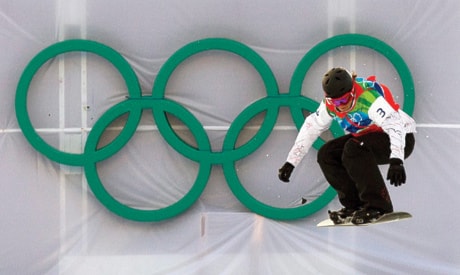LONDON — Snowboardcross was the most hazardous sport at the Winter Olympics in Vancouver, with nearly 75 per cent of female athletes sustaining injuries during the rough-and-tumble races, according to a medical study.
The report, published in the British Journal of Sports Medicine, found that at least 11 per cent of all athletes at the games in February sustained injuries — including 20 concussions.
The study reported a total of 287 injuries among the 2,567 athletes, including the “catastrophic injury” which caused the death of Georgian luger Nodar Kumaritashvili in a training crash a few hours before the opening ceremony on Feb. 12.
The findings illustrate some of the inherent dangers in pushing the boundaries in already risky high-speed winter sports.
“Overall, we are a little concerned about the increasing number of injuries that are not just minor,” International Olympic Committee medical commission head Arne Ljungqvist told The Associated Press on Monday. “Some of this can be regulated by stricter rules.
“But it seems there is a conflict — the interest of making sport more interesting perhaps but also a little more dangerous. Some athletes want to have more speed, but on the other hand we have to look after the safety of the athletes.”
The IOC-funded project is the first in-depth study of injuries at a Winter Olympics. It follows similar research at the 2008 Summer Games in Beijing, where nine per cent of athletes reported injuries.
Ljungqvist said the Vancouver report will serve as a basis for working with international federations to minimize injury risks at the 2014 Winter Games in Sochi, Russia.
The findings are based on reports from 82 national team doctors and designated medical centres in Vancouver and Whistler. The study said the actual figures were likely higher because not all injuries were reported.
About 25 per cent of the injuries were serious enough to result in athletes being unable to train or compete. The most common injury areas were the head, spine and knees; bruising and ligament and muscle sprains were the most frequent types of injury.
The highest-risk sports were bobsled, ice hockey, short-track speedskating, Alpine and freestyle skiing and snowboardcross, where between 15 per cent to 35 per cent of athletes sustained injuries.
The lowest risk were Nordic skiing, as well as luge, curling, speedskating and freestyle moguls — with less than five per cent of athletes being injured.
Snowboardcross was brought into the Olympics in 2006 to inject some X Games attitude into the Winter Games.
The study found that snowboardcross produced the highest percentage of injuries (35 per cent) of any Olympic events. An astounding 73 per cent of the women — 16 of the 22 competitors — sustained injuries. For men, the figure was 11 per cent — four of the 35 athletes.
It features athletes pushing, shoving and hurtling down a hill at breakneck speed. The sport’s cousin, skicross, made its debut in Vancouver.
“Snowboard and snowboardcross is where I see there is a potential for improving safety,” said professor Lars Engebretsen of the Norwegian School of Sports Sciences in Oslo, an author of the study.
“The fact is during the season leading up to the Olympics they also had high injury incidents during their World Cups and pre-Olympic qualification,” he told AP in a telephone interview.
Last week, a teenage member of the Russian national snowboard team was killed in a snowboardcross training accident in the Swiss Alps.
Among men in Vancouver, the highest rate of injuries was in short-track speedskating, with 27.8 per cent. The sport features close contact, high speeds and sharp turns.
Bobsled had a 20 per cent overall injury rate, followed by ice hockey at 18 per cent.
Engebretsen said scientists will spend the next six months studying videos of all the serious injuries to determine how they occurred.
Kumaritashvili’s fatal accident was the only injury reported in the luge competition, which could be partly attributed to the fact that organizers shortened the course in Whistler to make it safer after his death.
“My impression from before and looking at all the statistics from that sport (luge) is they did not have many injuries,” Engebretsen said. “This (fatal) incident was very, very unusual.”
The circumstances of the luge crash were not covered in the study.
Overall, the injury rate at the games was higher among women (13 per cent) than men (nine per cent).
The study found more than half the injuries in bobsled, skiing and snowboarding occurred as a result of contact with a stationary object. It urged organizers to create safe conditions to prevent further risks.
Although Ljungqvist expressed concern over an increase in injuries, Engebretsen said the 11 per cent figure was not high.
“I think it’s not a lot,” he said. “Compared to some other world championships, it’s actually a bit less.”
